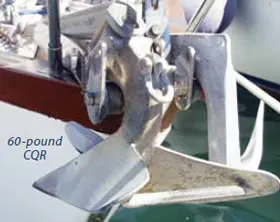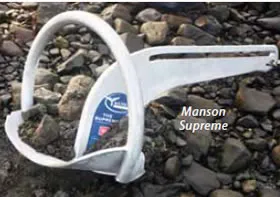
Photo by Joe Minick
After nearly four decades of being married to my CQR plow anchor, I decided to try a new anchoring solution aboard my Ericson 41, Wind Shadow, and mounted a Manson Supreme on her bow roller. Ill be long-term testing the Manson, but heres a preliminary look at the CQR and the Manson.
Dear old CQR
In 1975, I bought a 45-pound CQR plow for $249. The anchors design remains relatively unchanged, but today, the price is $835-a result of inflation rather than anchor gouging. The more important point, however, is that the CQRs tough, drop-forged steel shank and heavy-duty flukes have more than withstood the test of time. Our CQR earned high marks during a five-year voyage around the world and three other significant cruises we have made aboard Wind Shadow.
The CQR isn’t perfect, but its tendency to plow a furrow in the sea bottom rather than skimming over it allowed us to add anchor-rode scope or to get a second anchor down before we fetched up on whatever obstacles laid to leeward. In really bad weather, a three-piece Luke yachtsman pattern anchor, set on another rode, augmented the CQR. In short, the 45-pound CQR has done a yeomans job of keeping our 41-foot, 9-ton sloop where she belongs, and has proven worthy in a wide range of bottom conditions.

Photo by Evans Starzinger
Why switch to Manson?
Like most cruising sailors, Im always interested in a better-shaped jib, a more cooperative autopilot, and the anchor least likely to drag. For decades, Danforth/Fortress aficionados and Bruce advocates have pointed out that an anchor shaped like a farm plow shouldnt be expected to stay in one place. When a thunderstorm turns 15-knot tranquility into a 50-knot tempest, many of us have dragged our plows about a bit. Knockoffs fair about the same, and any plow owner who has not yet endured one of these fire drills, just hasn’t been at it long enough. So when the anchoring cognoscenti impugn the plow, to some extent, they have a point. In truth, the CQR isn’t at its best in all substrates, but for me, the anchors compatibility with an all-chain rode, its tendency to grab onto something regardless of the bottom composition, and its strength make it less likely to bend or break. All of these traits have kept the CQR Wind Shadows primary anchor for decades.
However, it seems that many new anchor designs offer engineering advancements. But engineering is only part of the puzzle; structural ruggedness and long-term reliability are just as important, as are handling ability and the overall quality control in the products manufacture.
I have an affinity for New Zealands marine metal fabrication, and Ive been following their domestic anchor evolution, including the mud wrestling between Manson and Rocna Anchors. Tactfully put, the Rocna and the Manson Supreme have marked similarities-both were influenced by the Spade Anchor design-and without getting into the debate over parentage, I went with the Kiwi-built Manson because of New Zealands reputation for quality control and the high-strength Bisalloy, high-tensile steel used in the all-important shank. The double-layered toe also adds stiffness where its needed most. The bottom line for me is that an anchor needs to have excellent engineering and metal fabrication; no matter how well it takes hold of the bottom, the resulting stresses and strains need to be taken in stride. These often go way beyond simple straight-line pulls.
CQR vs. Manson
The design comparison between the CQR and the Manson Supreme is interesting to note. The equivalent 45 pounds have been proportioned differently. The Manson has more of its mass in the claw-like fluke, and this offers a greater tendency to dig in and, once there, more surface area to help it stay put. The CQR has a longer, drop-forged shank that pivots on two hefty pins welded between the flukes, while the Mansons less-complicated, high-tensile-steel fixed shank is made from a plasma-cut flat plate. Both are effectively attached to their flukes and offer substantial side-load deformation resistance. The Manson shank is shorter and slotted to offer two methods of attachment, an attribute I plan to test further. The lengthy slot certainly lowers the bending resistance of the flat stock steel, but Manson has intentionally added enough width, cross section, and high-tensile steel to provide adequate resistance to bending.
There are probably ways to snafu some of the Manson Supremes ingenuity. Perhaps a piece of bottom detritus will get fouled in the closed aperture. Once, while attempting to anchor in Cape Town, South Africa, a fierce wind tried to blow us into a pier. We dragged across the anchorage and after retrieving 250 feet of chain, I found a 5-gallon paint bucket snagged over the flukes of the CQR. No anchor is immune to fouling.
Our future cruising will include plenty of real-world anchor testing of the Manson, and by this fall, well have a clear picture of how the CQR and Manson Supreme compare.



































